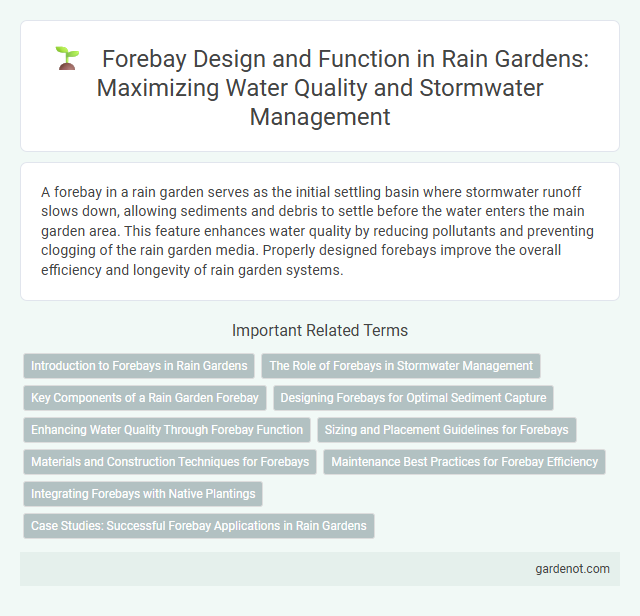A forebay in a rain garden serves as the initial settling basin where stormwater runoff slows down, allowing sediments and debris to settle before the water enters the main garden area. This feature enhances water quality by reducing pollutants and preventing clogging of the rain garden media. Properly designed forebays improve the overall efficiency and longevity of rain garden systems.
Introduction to Forebays in Rain Gardens
Forebays in rain gardens serve as initial sedimentation areas where runoff water first collects, allowing heavier particles and debris to settle before entering the main filtration zone. These structures improve the overall efficiency of rain gardens by reducing sediment load and preventing clogging of the planting media. Properly designed forebays enhance water quality and promote sustainable stormwater management in urban landscapes.
The Role of Forebays in Stormwater Management
Forebays serve as critical stormwater management structures by capturing and temporarily holding sediment-laden runoff before it enters the main rain garden, thereby reducing sedimentation and improving water quality. They facilitate the settling of heavy particles and debris, protecting downstream vegetation and enhancing infiltration efficiency. Effective forebay design optimizes pollutant removal while minimizing maintenance requirements within rain garden systems.
Key Components of a Rain Garden Forebay
A rain garden forebay serves as the initial settling area designed to capture and filter sediments, debris, and pollutants from stormwater runoff before it enters the main basin. Key components include a sedimentation zone with coarse gravel or stone to slow water flow, a raised berm or barrier to retain sediments, and an overflow outlet for excess water management. Effective forebay design enhances pollutant removal, prevents clogging in the rain garden, and supports overall stormwater treatment efficiency.
Designing Forebays for Optimal Sediment Capture
Forebays serve as preliminary sediment capture zones within rain gardens, designed to slow incoming stormwater and facilitate particle settling before water enters the main treatment area. Optimal forebay design incorporates sizing that accommodates the first flush volume, use of energy dissipation structures to reduce flow velocity, and vegetation or gravel media to enhance sediment retention. Properly engineered forebays improve overall rain garden efficiency by minimizing sediment load, protecting downstream systems, and reducing maintenance frequency.
Enhancing Water Quality Through Forebay Function
Forebays serve as critical sedimentation basins within rain gardens, effectively capturing and settling out coarse sediments and debris before water enters the main infiltration area. By slowing runoff and promoting sediment deposition, forebays significantly reduce pollutant loads, such as heavy metals and nutrients, improving overall water quality. Their strategic placement maximizes pollutant removal efficiency, ensuring cleaner stormwater infiltration and protecting downstream aquatic ecosystems.
Sizing and Placement Guidelines for Forebays
Forebays should be sized to capture 10-15% of the total rain garden volume to effectively settle out sediment and debris before water enters the main planting area. Placement is critical; locate forebays at the inflow point of the rain garden where runoff first enters, ensuring optimal sediment deposition and maintenance access. Proper sizing and strategic placement enhance the rain garden's performance by protecting plant roots and improving water quality.
Materials and Construction Techniques for Forebays
Forebays typically utilize gravel, sand, and organic mulch as primary materials to trap sediments and pollutants effectively. Construction involves creating a stable basin with properly graded slopes and geotextile liners to prevent erosion and enhance infiltration. Incorporating a sediment trap or forebay baffle helps in optimizing sediment capture and prolonging the forebay's maintenance cycle.
Maintenance Best Practices for Forebay Efficiency
Regular inspection and sediment removal are crucial to maintain forebay efficiency in rain gardens, preventing clogging and promoting optimal water flow. Vegetation management, including trimming and replacing dead plants, supports filtration and erosion control. Ensuring proper grading and repairing any structural damage enhances sediment capture and prolongs forebay functionality.
Integrating Forebays with Native Plantings
Integrating forebays with native plantings enhances sediment capture and improves water quality by promoting natural filtration processes. Native plants stabilize soil around the forebay, reducing erosion while providing habitat for local wildlife and supporting biodiversity. Strategic selection of deep-rooted, water-tolerant species ensures optimal nutrient uptake and long-term maintenance of the rain garden's ecological function.
Case Studies: Successful Forebay Applications in Rain Gardens
Successful forebay applications in rain gardens enhance sediment capture and improve water quality by pre-treating stormwater before it enters the main garden basin. Case studies from urban projects in Seattle and Portland demonstrate forebays reducing sediment loads by up to 85%, significantly extending rain garden lifespan and reducing maintenance frequency. These designs optimize pollutant removal efficiency while promoting groundwater recharge and mitigating urban runoff impacts.
Forebay Infographic

 gardenot.com
gardenot.com